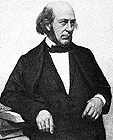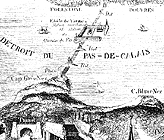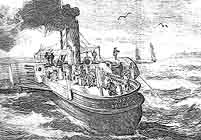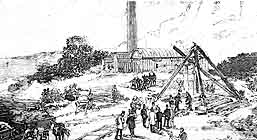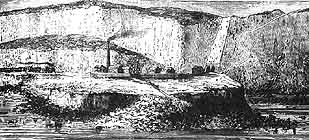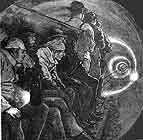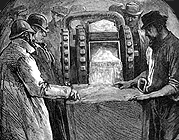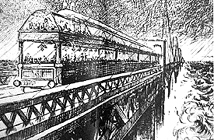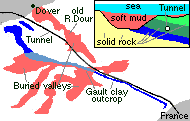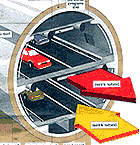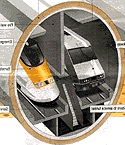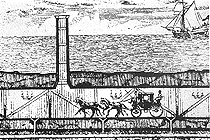 Albert Mathieu presented Napoleon with a scheme for a tunnel during the brief Peace of Amiens in 1802  Fanciful scheme for a French invasion of England during the Napoleonic Wars (cartoon drawn c.1804. |
Why wasn't it built before? First impractical suggestions in
the Napoleonic Wars Both schemes existed only on paper. They lacked the technology to overcome the problems, and did not have the necessary geological knowledge. They guessed that the chalk of Cap Blanc Nez ran under the sea all the way to the white cliffs of Dover - no-one really knew. They imagined horse-drawn carriages driving down a wood-propped tunnel like mines of the day, lit by candles. A railway tunnel -
a cure for seasickness! Victorian engineers thought they
could do it! Confident French and English engineers now approached the task of planning to construct a 25-mile undersea tunnel in earnest..... Back to top |
|
|
The problems tunnellers faced:
Frenchman Thomé de Gamond worked hard to
find convincing answers: His plan - see left - had an international port built mid-way on an artificial island on the Varne sandbank. Steam trains would run from the Paris-Amiens-Boulogne line on a double track through a single gas-lit tunnel. Ventilation was provided by the mid-way opening at the Varne. Back to top |
|
First
serious attempts to build a
tunnel 1870's: checking the
geology Both countries agreed to work together on a joint tunnel scheme to bring them closer together. With government approval, tunnel companies were set up to do the first serious scientific exploration of the geology - to find out just what rocks lay under the sea bed between Dover and Calais.... 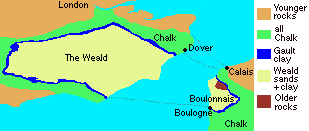 The Lower Chalk bed proved the best part of the chalk for tunnelling: it is....
|
|
|
1880-83:
trial tunnels dug either side A technical success? Technically, it was a success - driven by compressed air, the boring machines worked well, and there was so little flooding they only switched the pumps on for half a day every two weeks! Within the first year, each side had bored almost 2 km of tunnel, and they expected to complete a 7 foot diameter pilot tunnel across the Channel within 5 years. They planned the tunnel trains would also be powered by compressed air - solving the problem of smoke and fumes. Soon the invention of clean electric trains offered an even better solution. Tunnel abandoned - fear of a French
invasion It was no good! The British generals did not trust the French, and that was that. The French tunnellers gave up - believing the British would always be stubborn about staying as an "island fortress". Meanwhile on the Dover side, though the Tunnel was
abandoned, they drilled their shaft deeper and in 1890
discovered coal and iron-ore seams - hidden extensions of
the coalfields of northern France and Belgium: see Formation
of coal) |
|
|
1914-18
- the tunnel could have supplied the Trenches During the First World War, fresh troops, munitions and supplies had to cross the Channel under constant fire from enemy ships, submarines, airships and aircraft - needing the protection of the Dover Patrol. Wounded soldiers were also in danger returning home from the Front. It was estimated that the Tunnel could have shortened the war by 2 years - in fact, the Germans might not have invaded France if the Tunnel had been built! As it was, the Germans very nearly won..... More talking - no
action |
|
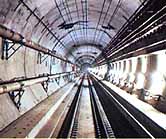 Newly completed tunnel in 1993 - it followed more or less the same route underground as planned in 1880 and 1974 - it could have been celebrating its centenary! |
1974-75:
the second attempt 1987-94 - third time
lucky! Work stated on both sides in 1987, and the fixed link was opened in 1994 - nearly 2 years late, and way over budget. ...but the tunnel doesn't
kill the ferries |
|
|
Checking
the geology AGAIN
|
||
|
How the
Tunnel operates The tunnel copies some of the Alpine mountain tunnels in carrying cars and lorries on drive-on/drive-off shuttle trains. Operated by Eurotunnel "le Shuttle", these share the tracks with high speed long-distance passenger trains run by Eurostar. All trains are electric, and the twin tunnel While the vehicle shuttle competes head-on with the ferries, Eurostar trains regard their main competitor as the airlines. They charge fares to match airline business tickets, and soon siezed 80% of the London-Paris market. Back to top |
||
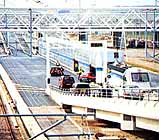 Cars just drive on the double-deck shuttle train: freight lorries have their own trains. |
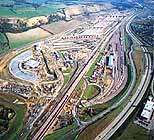 Folkestone shuttle terminal next to the M20 motorway - 35 minutes from France. |
High speed rail
links On the English side, the first stage of a purpose-built line from the Tunnel to London is planned to be open in 2003 (see links below) |
|
|
A second
tunnel? Although cross-channel traffic is increasing steadily, and the first tunnel covers its running costs, it has made slow progress in paying off its enormous debt from the construction. No-one is likely to be keen to build a second tunnel in the near future - so this feasabilty study will probably go no further. A road or rail tunnel? |
|
|
Building the high-speed rail link from the Channel Tunnel to London: www.ctrl.co.uk |
||||
|
Places to
visit: |
|||||
|
Related background
information |
|
|
|
|
|
|

